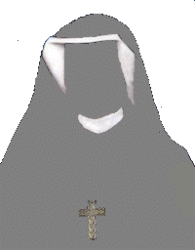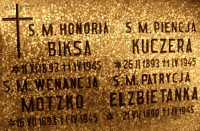Roman Catholic
St Sigismund parish
05-507 Słomczyn
85 Wiślana Str.
Konstancin deanery
Warsaw archdiocese, Poland
full list:
displayClick to display full list

searchClick to search full list by categories
wyświetlKliknij by wyświetlić pełną listę po polsku

szukajKliknij by przeszukać listę wg kategorii po polsku

Martyrology of the clergy — Poland
XX century (1914 – 1989)
personal data

surname
ELŻBIETANKA
religious forename(s)
Mary Patricia (pl. Maria Patrycja)
function
nun
creed
Latin (Roman Catholic) Church RCmore on
en.wikipedia.org
[access: 2014.09.21]
congregation
Congregation of the Silesian Handmaid Nuns of Mary Immaculate Conception ABMVślmore on
www.sluzebniczki.pl
[access: 2012.11.23]
(i.e. Handmaids of Silesia)
date and place
of death
01.04.1945

Wrocławtoday: Wrocław city pov., Lower Silesia voiv., Poland
more on
en.wikipedia.org
[access: 2021.04.02]
details of death
Perished during Russian winter 1945 offensive ending the military conflict of the World War II, started by German and Russian invasion of Poland in 09.1939, during siege and German–Russian battle of Wrocław (13.02.1945–06.05.1945), under rubble of the Palace of the Suffraganes where she tended to old and infirm women.
Perished together with three other nuns: Sr Clara Biksa, Sr Pientia Kuczera and Sr Venantia Motzko, and few of their patients.
On 01.04.1945 was Easter Sunday. At c. 08:30, a continuous raid of Russian planes began ‐ c. 750 sorties were counted, the German anti–aircraft defense in practice did not work — on the city, lasting until c. 17:00. Witnesses recalled: „On Easter Sunday, April 1, hell on earth began; the strongest air bombardment Wrocław has ever known. Debris was falling. The streets were on fire. Houses were burning. People were going crazy […] A sea of fire all around”. „An unimaginable, hurricane–like fire was raging everywhere […] The streets leading from the Market Square to all directions were on fire. Thousands of sparks thrown from window openings flew along the streets and over the roofs. And they constantly found new food in the ancient, dried roof trusses of this district [Old Town] filled with old buildings”. „In the evening, Russian guns fell silent on several sections of the front at once. The dead silence that followed was soon broken by propaganda texts from mobile Russian megaphones: «Come to us! You'll get goulash and noodles. Thousands of beautiful women's legs are waiting for you!»” At c. 10:30 bombs fell on the cathedral — „it was the turn of the symbol of the city — the cathedral: its huge towers burned like torches until only stumps remained” — and the nearby Germ. „Haus der Suffragane” (Eng. „Palace of the Suffraganes”).
Bombs hit its western wing when the Easter Holy Mass was celebrated in the so‐called crypt, a large, vaulted palace basement. As a result of the bombing, one of the basements collapsed and she perished in it…
cause of death
shelling (bombardment)
perpetrators
Russians
sites and events
Ribbentrop‐MolotovClick to display the description, Pius XI's encyclicalsClick to display the description
date and place
of birth
21.07.1890

positions held
till 1945
nun — Wrocławtoday: Wrocław city pov., Lower Silesia voiv., Poland
more on
en.wikipedia.org
[access: 2021.04.02] ⋄ General House, Handmaids of Silesia ABMVśl — prob.
others related
in death
BIKSAClick to display biography Claire (Sr Mary Honoria), KUCZERAClick to display biography Mary (Sr Mary Pientia), MOĆKOClick to display biography Mary Rosalie (Sr Mary Venantia), BRANDYSClick to display biography Hubert, MIKOSZClick to display biography Mary (Sr Paula), SKLORZClick to display biography Hedwig (Sr Augustina)
sites and events
descriptions
Ribbentrop‐Molotov: Genocidal Russian‐German alliance pact between Russian leader Joseph Stalin and German leader Adolf Hitler signed on 23.08.1939 in Moscow by respective foreign ministers, Mr. Vyacheslav Molotov for Russia and Joachim von Ribbentrop for Germany. The pact sanctioned and was the direct cause of joint Russian and German invasion of Poland and the outbreak of the World War II in 09.1939. In a political sense, the pact was an attempt to restore the status quo ante before 1914, with one exception, namely the „commercial” exchange of the so‐called „Kingdom of Poland”, which in 1914 was part of the Russian Empire, fore Eastern Galicia (today's western Ukraine), in 1914 belonging to the Austro‐Hungarian Empire. Galicia, including Lviv, was to be taken over by the Russians, the „Kingdom of Poland” — under the name of the General Governorate — Germany. The resultant „war was one of the greatest calamities and dramas of humanity in history, for two atheistic and anti‐Christian ideologies — national and international socialism — rejected God and His fifth Decalogue commandment: Thou shall not kill!” (Abp Stanislav Gądecki, 01.09.2019). The decisions taken — backed up by the betrayal of the formal allies of Poland, France and Germany, which on 12.09.1939, at a joint conference in Abbeville, decided not to provide aid to attacked Poland and not to take military action against Germany (a clear breach of treaty obligations with Poland) — were on 28.09.1939 slightly altered and made more precise when a treaty on „German‐Russian boundaries and friendship” was agreed by the same murderous signatories. One of its findings was establishment of spheres of influence in Central and Eastern Europe and in consequence IV partition of Poland. In one of its secret annexes agreed, that: „the Signatories will not tolerate on its respective territories any Polish propaganda that affects the territory of the other Side. On their respective territories they will suppress all such propaganda and inform each other of the measures taken to accomplish it”. The agreements resulted in a series of meeting between two genocidal organization representing both sides — German Gestapo and Russian NKVD when coordination of efforts to exterminate Polish intelligentsia and Polish leading classes (in Germany called «Intelligenzaktion», in Russia took the form of Katyń massacres) where discussed. Resulted in deaths of hundreds of thousands of Polish intelligentsia, including thousands of priests presented here, and tens of millions of ordinary people,. The results of this Russian‐German pact lasted till 1989 and are still in evidence even today. (more on: en.wikipedia.orgClick to attempt to display webpage
[access: 2015.09.30])
Pius XI's encyclicals: Facing the creation of two totalitarian systems in Europe, which seemed to compete with each other, though there were more similarities than contradictions between them, Pope Pius XI issued in 03.1937 (within 5 days) two encyclicals. In the „Mit brennender Sorge” (Eng. „With Burning Concern”) published on 14.03.1938, condemned the national socialism prevailing in Germany. The Pope wrote: „Whoever, following the old Germanic‐pre‐Christian beliefs, puts various impersonal fate in the place of a personal God, denies the wisdom of God and Providence […], whoever exalts earthly values: race or nation, or state, or state system, representatives of state power or other fundamental values of human society, […] and makes them the highest standard of all values, including religious ones, and idolizes them, this one […] is far from true faith in God and from a worldview corresponding to such faith”. On 19.03.1937, published „Divini Redemptoris” (Eng. „Divine Redeemer”), in which criticized Russian communism, dialectical materialism and the class struggle theory. The Pope wrote: „Communism deprives man of freedom, and therefore the spiritual basis of all life norms. It deprives the human person of all his dignity and any moral support with which he could resist the onslaught of blind passions […] This is the new gospel that Bolshevik and godless communism preaches as a message of salvation and redemption of humanity”… Pius XI demanded that the established human law be subjected to the natural law of God , recommended the implementation of the ideal of a Christian state and society, and called on Catholics to resist. Two years later, National Socialist Germany and Communist Russia came together and started World War II. (more on: www.vatican.vaClick to attempt to display webpage
[access: 2023.05.28], www.vatican.vaClick to attempt to display webpage
[access: 2023.05.28])
sources
personal:
www.zajezdnia.orgClick to attempt to display webpage
[access: 2023.12.26]
bibliographical:
„Martyrology of the Polish Roman Catholic clergy under nazi occupation in 1939‐1945”, Victor Jacewicz, John Woś, vol. I‐V, Warsaw Theological Academy, 1977‐1981
original images:
www.bagnowka.comClick to attempt to display webpage
[access: 2015.04.18]
LETTER to CUSTODIAN/ADMINISTRATOR
If you have an Email client on your communicator/computer — such as Mozilla Thunderbird, Windows Mail or Microsoft Outlook, described at WikipediaPatrz:
en.wikipedia.org, among others — try the link below, please:
LETTER to CUSTODIAN/ADMINISTRATORClick and try to call your own Email client
If however you do not run such a client or the above link is not active please send an email to the Custodian/Administrator using your account — in your customary email/correspondence engine — at the following address:

giving the following as the subject:
MARTYROLOGY: ELŻBIETANKA
To return to the biography press below:
 Click to return to biography
Click to return to biography








